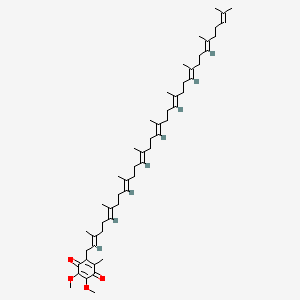| Authors | Title | Published | Journal | PubMed Link |
|---|---|---|---|---|
| Lekli I et al. | Coenzyme Q9 provides cardioprotection after converting into coenzyme Q10. | 2008 | J. Agric. Food Chem. | pmid:18543930 |
| RodrÃguez-Acuña R et al. | Determination of coenzyme Q10 and Q9 in vegetable oils. | 2008 | J. Agric. Food Chem. | pmid:18616270 |
| Acworth IN et al. | Determination of oxidized and reduced CoQ10 and CoQ9 in human plasma/serum using HPLC-ECD. | 2008 | Methods Mol. Biol. | pmid:19082952 |
| Li L et al. | Analysis of CoQ10 in rat serum by ultra-performance liquid chromatography mass spectrometry after oral administration. | 2008 | J Pharm Biomed Anal | pmid:18054195 |
| Duncan AJ et al. | A nonsense mutation in COQ9 causes autosomal-recessive neonatal-onset primary coenzyme Q10 deficiency: a potentially treatable form of mitochondrial disease. | 2009 | Am. J. Hum. Genet. | pmid:19375058 |
| Shelley P et al. | Altered skeletal muscle insulin signaling and mitochondrial complex II-III linked activity in adult offspring of obese mice. | 2009 | Am. J. Physiol. Regul. Integr. Comp. Physiol. | pmid:19535678 |
| Bae JS et al. | Apoptotic cell death of human leukaemia U937 cells by ubiquinone-9 purified from Pleurotus eryngii. | 2009 | Nat. Prod. Res. | pmid:19662576 |
| Yang YY et al. | The effect of different ubiquinones on lifespan in Caenorhabditis elegans. | 2009 | Mech. Ageing Dev. | pmid:19428456 |
| Sumien N et al. | Prolonged intake of coenzyme Q10 impairs cognitive functions in mice. | 2009 | J. Nutr. | pmid:19710165 |
| Cano A et al. | Hepatic VLDL assembly is disturbed in a rat model of nonalcoholic fatty liver disease: is there a role for dietary coenzyme Q? | 2009 | J. Appl. Physiol. | pmid:19608932 |
Coenzyme Q9
Coenzyme q9 is a lipid of Prenol Lipids (PR) class. The involved functions are known as Diastasis, Phosphorylation and Cardiac function.
Cross Reference
Introduction
To understand associated biological information of Coenzyme Q9, we collected biological information of abnormalities, associated pathways, cellular/molecular locations, biological functions, related genes/proteins, lipids and common seen animal/experimental models with organized paragraphs from literatures.
What diseases are associated with Coenzyme Q9?
There are no associated biomedical information in the current reference collection.
No disease MeSH terms mapped to the current reference collection.
PubChem Associated disorders and diseases
What pathways are associated with Coenzyme Q9
There are no associated biomedical information in the current reference collection.
PubChem Biomolecular Interactions and Pathways
Link to PubChem Biomolecular Interactions and PathwaysWhat cellular locations are associated with Coenzyme Q9?
There are no associated biomedical information in the current reference collection.
What functions are associated with Coenzyme Q9?
Related references are published most in these journals:
| Function | Cross reference | Weighted score | Related literatures |
|---|
What lipids are associated with Coenzyme Q9?
There are no associated biomedical information in the current reference collection.
What genes are associated with Coenzyme Q9?
There are no associated biomedical information in the current reference collection.
What common seen animal models are associated with Coenzyme Q9?
There are no associated biomedical information in the current reference collection.
